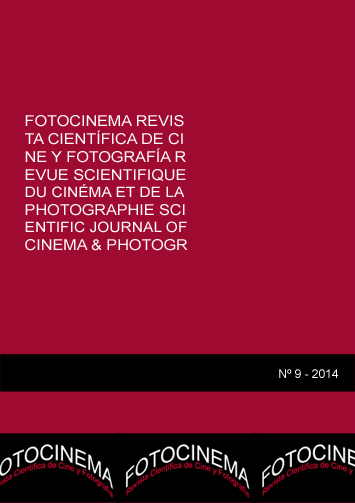Sísifos modernos: narrativas no lineales aplicadas a las adaptaciones de videojuegos en la animación japonesa
DOI:
https://doi.org/10.24310/Fotocinema.2014.v0i9.5968Abstract
Este artículo propone un acercamiento al creciente número de películas y series pertenecientes a la animación japonesa comercial que explotan las posibilidades narrativas de los bucles temporales dentro de la tendencia de las mind-game films. En particular, se quiere atender a la particular relación que los dispositivos narrativos de las series Steins;Gate (H. Hamasaki & T. Sato, White Fox, 2011) y Higurashi no Naku Koro ni (C. Kon, Studio Deen, 2006) establecen con las narrativas de los videojuegos con finales alternativos de los que parten. En ambos casos, sus personajes se ven forzados a repetir eternamente un destino fatal al haber transgredido las normas de su realidad mediante los viajes en el tiempo. Este tormento se convierte así en una consecuencia de la violación de la linealidad y la causalidad de los relatos clásicos y del Modo de Representación Institucional. La única salida posible del bucle será la reconstrucción de la trama y la restitución de la unicidad del relato.
Abstract:
This article proposes an approach to the growing number of Japanese animation films and television series that make use of the narrative possibilities of time loops within the trend of the mind-game films. Particularly, this paper refers to the particular relation that the narrative devices of the series Steins;Gate (H. Hamasaki & T. Sato, White Fox, 2011) and Higurashi no Naku Koro ni (C. Kon, Studio Deen, 2006) regarding the alternate endings narrative of the video games they are based on. In both cases, their characters are forced to do over a fatal destiny ad nauseam because of them violating their reality through time travelling. This torment becomes a metaphor about the transgression of linearity and causality of the classical filmmaking and the Institutional Mode of Representation. The only way out of the loop is the reconstruction of the plot to the restitution of the story.
Palabras clave:
Anime; Visual novel; Animación japonesa; Cine postclásico; Videojuegos; Mind-game films
Keywords:
Anime; Visual novel; Japanese Animation; Post-classical Cinema; Video games; Mind-game filmsDownloads
Metrics
Publication Facts
Reviewer profiles N/A
Author statements
Indexed in
-
—
- Academic society
- N/A
- Publisher
- Universidad de Málaga
Downloads
Published
How to Cite
Issue
Section
License
All contents published in Fotocinema Revista científica de cine y fotografía are protected under the Creative Commons Attribution-NonCommercial-ShareAlike 4.0 International (CC BY-NC-SA 4.0) license. All about this license is available in the following link: <http://creativecommons.org/licenses/by-nc-sa/4.0>
Users can copy, use, redistribute, share and exhibit publicly as long as:
- The original source and authorship of the material are cited (Journal, Publisher and URL of the work).
- It is not used for comercial purposes.
- The existence of the license and its especifications are mentioned.
There are two sets of authors’ rights: moral and property rights. Moral rights are perpetual prerogatives, unrenounceable, not-transferable, unalienable, imprescriptible and inembargable. According to authors’ rights legislation, Fotocinema. Revista científica de cine y fotografía recognizes and respects authors moral rights, as well as the ownership of property rights, which will be transferred to University of Malaga in open access. The property rights are referred to the benefits that are gained by the use or the dissemination of works. Fotocinema. Revista científica de cine y fotografía is published in an open access form and it is exclusively licenced by any means for doing or authorising distribution, dissemination, reproduction, , adaptation, translation or arrangement of works.
Authors are responsable for obtaining the necessary permission to use copyrighted images.














13.png)



